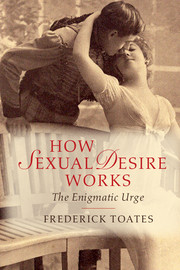Book contents
- Frontmatter
- Dedication
- Contents
- List of figures
- Preface
- One What is enigmatic about sexual desire?
- Two Explaining desire: multiple perspectives
- Three Sexual desire in a broad context
- Four An incentive-based model
- Five Sex and levels of organization
- Six Sexual attraction
- Seven Shades of desire from simple to complex
- Eight Details of the brain and desire
- Nine Arousal
- Ten The consequences of sexual behaviour and associated expectations
- Eleven Sexual familiarity and novelty
- Twelve Inhibition, conflict and temptation
- Thirteen How did sexual desire get here?
- Fourteen Setting the trajectory: link to adult sexuality
- Fifteen Sexual desire in interaction
- Sixteen Representations of sex
- Seventeen Sexual addiction
- Eighteen Variations in desire: general principles
- Nineteen Some forms of desire at the fringes
- Twenty The toxic fusion: violence and sexual desire
- Twenty one Sexually associated (serial) murder
- Twenty two Concluding remarks
- Notes
- References
- Index
Preface
Published online by Cambridge University Press: 05 October 2014
- Frontmatter
- Dedication
- Contents
- List of figures
- Preface
- One What is enigmatic about sexual desire?
- Two Explaining desire: multiple perspectives
- Three Sexual desire in a broad context
- Four An incentive-based model
- Five Sex and levels of organization
- Six Sexual attraction
- Seven Shades of desire from simple to complex
- Eight Details of the brain and desire
- Nine Arousal
- Ten The consequences of sexual behaviour and associated expectations
- Eleven Sexual familiarity and novelty
- Twelve Inhibition, conflict and temptation
- Thirteen How did sexual desire get here?
- Fourteen Setting the trajectory: link to adult sexuality
- Fifteen Sexual desire in interaction
- Sixteen Representations of sex
- Seventeen Sexual addiction
- Eighteen Variations in desire: general principles
- Nineteen Some forms of desire at the fringes
- Twenty The toxic fusion: violence and sexual desire
- Twenty one Sexually associated (serial) murder
- Twenty two Concluding remarks
- Notes
- References
- Index
Summary
Sexual desire could at times appear to bring pleasure and misery in somewhat equal proportions. It is my firm conviction that a better understanding of it can help to tilt the weight away from misery, the present book being based upon the belief that knowledge is empowering. For example, rightly or wrongly, people sometimes think that their tastes are socially and morally unacceptable and better knowledge could prove valuable in seeing how the taste might have arisen and coming to terms with it. Similarly, couples frequently find that discord arises from divergent tastes or intensities of desire. Insights into how desire works might yield greater tolerance of differences and thereby harmony. To give a full account of the range of desires, Chapters 20–1 describe the nightmare world of sexual violence, for which, of course, there can be no degrees of tolerance. I believe that a greater insight into the causes of sexual violence could help to combat it. However, the reader seeking only insight into harmonious and consensual sex might wish to skip these two chapters.
I have a wide range of different readers in mind, such as neuroscientists, psychologists, psychiatrists, philosophers, counsellors, teachers, social workers, police and probation officers, as well as the general public. I have tried very hard to write it in a style that is accessible to such a spectrum of different readers and I can only hope that I have succeeded. To respect such a spectrum, some information on, for example, details of brain processes is put in footnotes, which can be ignored without losing the story-line.
- Type
- Chapter
- Information
- How Sexual Desire WorksThe Enigmatic Urge, pp. xi - xiiPublisher: Cambridge University PressPrint publication year: 2014

